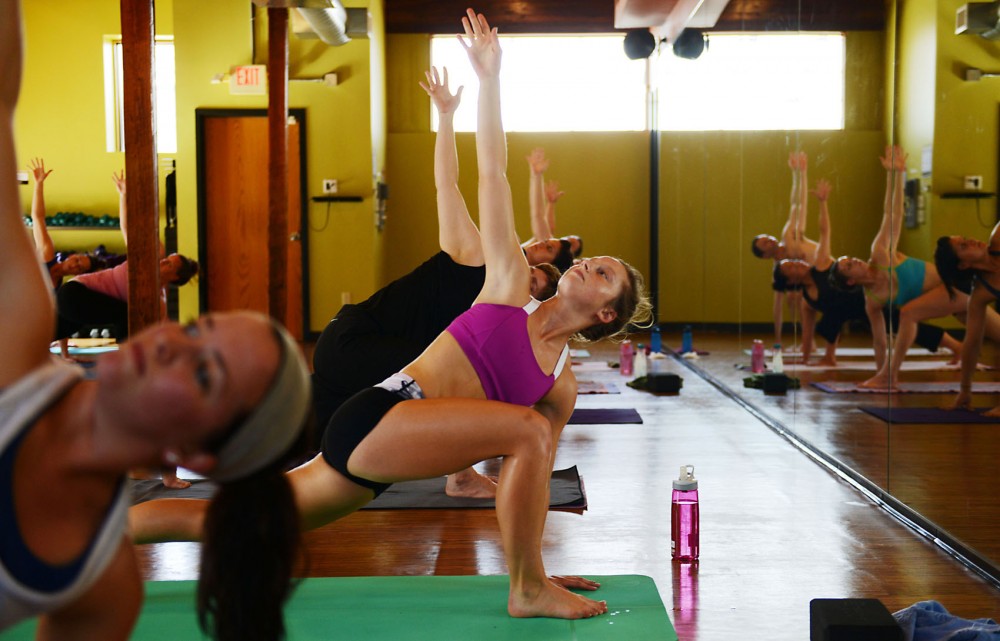The thermometer read 98 degrees Fahrenheit. Humidity was 30 percent.
The yoga students reverse swan dived back into a standing pose, sweat rolling off their noses onto the mats below. Continuing to recite the positions, the instructor moved through the sticky space, helping participants contort their bodies correctly.
Hot yoga is one of many health trends — ranging from frozen yogurt to protein supplements — that have gained popularity among students.
The Minnesota Daily spoke with health experts to determine whether popular student activities are as healthy as they seem.
Hot yoga
Is it healthy? Verdict: It depends
Sophomore Emily Huff said she would go to hot yoga sessions whenever she didn’t have night classes last year.
“I got completely addicted to it,” she said.
She said she felt refreshed after being “drenched” in sweat in the nearly-100-degree room.
Heated yoga helps some student participants feel cleansed, they say, but experts warn that they should take it slow to minimize risk.
All of the classes at CorePower Yoga in Stadium Village are heated, said studio assistant Kayla Preston. For the studio’s traditional hot yoga class, she said, the temperature can be set as high as 105 degrees.
With the added heat, muscles loosen up, she said, making it easier for students who aren’t used to yoga to grasp the positions.
University of Minnesota students make up a majority of the studio’s yogis, Preston said.
Although hot yoga can make it easier to burn more calories, it isn’t a good idea for everyone, said Margaret Belew, a Boynton Health Service physical therapist. If students decide to try it, she said, she suggests being slow and careful.
Belew also said she hasn’t seen evidence supporting the claim that hot yoga helps cleanse or detox participants.
Yoga instructors are on the lookout for participants who aren’t feeling well, Preston said, and do their best to prevent students from overexerting themselves or becoming dehydrated.
“We try to avoid it the best we can,” she said.
Juicing
Is it healthy? Verdict: Yes
Blending fruits and vegetables to make drinkable juices is a great way to get the recommended daily doses of those foods, experts say, but it shouldn’t replace meals.
Turning fruits and vegetables into juice provides the micronutrients they contain, like vitamins, minerals and sugar, even if the food isn’t solid, said Katie Kasner, a BHS-registered dietitian.
But students should get a variety of foods in their diet, said Jenna Brott, University Dining Services health and wellness coordinator and a registered dietitian. Meeting that goal requires eating solid food, not just drinking juice.
“If they’re using it as a way to kind of boost their nutrition in addition to a balanced meal, then that’s wonderful,” Kasner said.
Eating whole fruits and vegetables also provides much-needed fiber that juice doesn’t, Kasner said.
Insanity workouts
Is it healthy? Verdict: It depends
While so-called “insanity workouts” can build fitness, they can also cause injury, Belew said.
These workouts, like the popular P90X, encourage participants to exert themselves intensely and for long periods of time, she said.
The young and healthy are more suited for these types of workouts, she said.
All participants should ease into the workout routine and not follow the program verbatim, she said, adding that she’s treated patients who injured themselves during insanity workouts.
Frozen yogurt
Is it healthy? Verdict: Not really
Chilly Billy’s and Yogurt Lab are popular destinations for students looking for a sweet and supposedly healthy treat.
If students eat frozen yogurt in moderation and choose nonfat or low-fat options, it can be a lower-calorie substitute for ice cream, experts say.
Sometimes, people perceive frozen yogurt as a healthier item and eat too much of it, Brott said, so it’s important to consume it in moderation.
Also, adding toppings that aren’t fruits and vegetables can drive up the calorie count, Kasner said, so she suggests staying away from the cookies and candy.
Protein supplements
Is it healthy? Verdict: Not really
Students hoping to bulk up at the gym often turn to protein supplements, but experts say to be careful.
Brott and Belew said they weren’t knowledgeable about all types of supplements, but said whey protein could be used safely.
Taking too much protein can cause kidney damage in extreme cases, Brott said.
People who want to take protein supplements should be sure they don’t go over the recommended amount of protein. This amount is different for certain types of people, she said, so they should check with a doctor or dietitian or look online at choosemyplate.gov.
Whey protein can be taken if students don’t get protein elsewhere in their diet, Brott said. But it’s best to eat actual foods and have a balanced diet.








